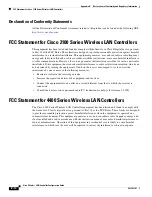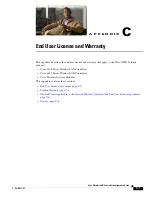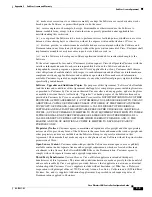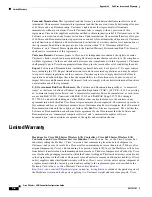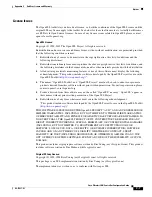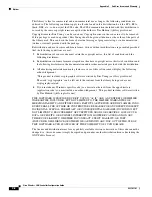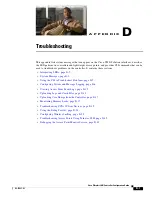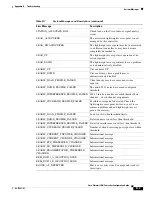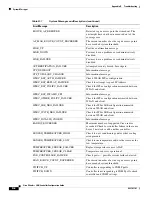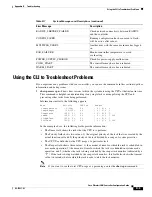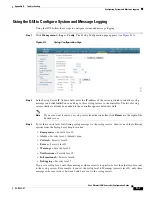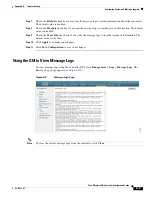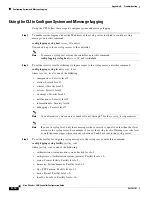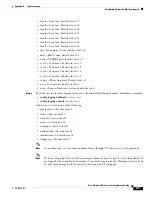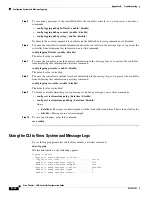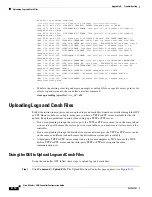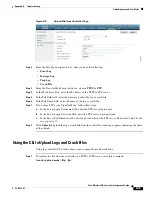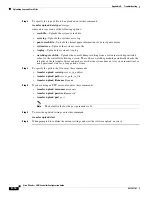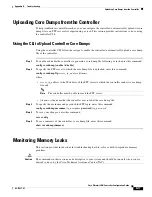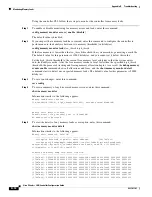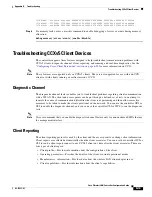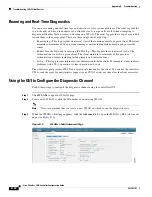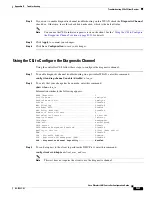
D-6
Cisco Wireless LAN Controller Configuration Guide
OL-17037-01
Appendix D Troubleshooting
Configuring System and Message Logging
2.
show process memory
—Shows the allocation and deallocation of memory from various processes
in the system at that instant in time.
Information similar to the following appears:
Name Priority BytesInUse BlocksInUse Reaper
reaperWatcher ( 3/124) 0 0
( 0/ 0)% I
osapiReaper (10/121) 0
0
( 0/ 0)% I
TempStatus (255/ 1) 308 1
( 0/ 0)% I
emWeb (255/ 1) 294440 4910
( 0/ 0)% T 300
cliWebTask (255/ 1) 738 2
( 0/ 0)% I
UtilTask (255/ 1) 308 1
( 0/ 0)% T 300
In the example above, the following fields provide information:
•
The Name field shows the tasks that the CPU is to perform.
•
The Priority field shows two values: 1) the original priority of the task that was created by the
actual function call and 2) the priority of the task divided by a range of system priorities.
•
The BytesInUse field shows the actual number of bytes used by dynamic memory allocation for
a particular task.
•
The BlocksInUse field shows the chunks of memory that are assigned to perform a particular
task.
•
The Reaper field shows three values: 1) the amount of time for which the task is scheduled in
user mode operation, 2) the amount of time for which the task is scheduled in system mode
operation, and 3) whether the task is being watched by the reaper task monitor (indicated by a
“T”). If the task is being watched by the reaper task monitor, this field also shows the timeout
value (in seconds) before which the task needs to alert the task monitor.
3.
show tech-support
—Shows an array of information related to the state of the system, including the
current configuration, last crash file, CPU utilization, and memory utilization.
4.
show run-config
—Shows the complete configuration of the controller. To exclude access point
configuration settings, use the
show run-config no-ap
command.
Note
If you want to see the passwords in clear text, enter
config passwd-cleartext enable
. To
execute this command, you must enter an admin password. This command is valid only for
this particular session. It is not saved following a reboot.
5.
show run-config commands
—Shows the list of configured commands on the controller. This
command shows only values configured by the user. It does not show system-configured default
values.
Configuring System and Message Logging
System logging allows controllers to log their system events to up to three remote syslog servers. The
controller sends a copy of each syslog message as it is logged to each syslog server configured on the
controller. Being able to send the syslog messages to multiple servers ensures that the messages are not
lost due to the temporary unavailability of one syslog server. Message logging allows system messages
to be logged to the controller buffer or console.
You can use the controller GUI or CLI to configure system and message logging.

